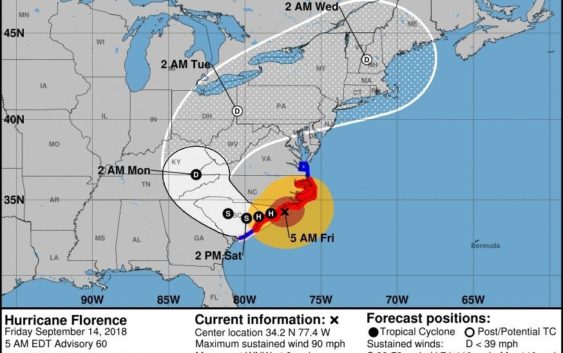- Even light rain causing flash flooding issues on Houston's north side
- LIST: High water locations, street flooding as heavy rain falls in the Houston area
- China on Alert for Heavy Rain and Floods From Typhoon Gaemi
- Flash flood threat; A day to be Weather Aware
- Power-Thirsty Bitcoin Miners Are Flooding the Energy Center of Texas
8 A.M. Update: Florence roars into Wilmington

Wind, storm surges and prolonged, heavy rain bring ‘life-threatening’ conditions to region
Wilmington should be ready for a prolonged and devastating impact as Hurricane Florence roars over Southeastern North Carolina on Friday.
“It’s probably going to take another 24 hours” for Florence to pass through the Wilmington region, Reid Hawkins, science officer with the National Weather Service office in Wilmington, said at 5 a.m. Friday.
According to radar images as of 7 a.m., the storm’s eye was drawing near the New Hanover-Pender County line. Meteorologists at the National Weather Service’s Wilmington office are waiting for the National Hurricane Center to confirm the track of the eyeball, which typically has the storm’s strongest winds.
>>READ MORE: Click here for complete coverage of Hurricane Florence.
As Hurricane Florence crashed onto the Carolinas, federal emergency teams prepared themselves to work on a long process of rebuilding the storm-battered landscape it would leave behind.
“We call them disasters because they break things,” FEMA Administrator Brock Long told reporters while Florence was bearing down on the coastline. “The infrastructure is going to break. … The power is going to go out. It could be out for a number of days.”
FEMA’s first priority after Florence passes will be getting infrastructure that’s critical to communities’ well-being up and running, Long said.
“We’ve got to quickly understand the damage that’s been done to the transportation systems, the communication systems, the power systems, and we are positioning, and have bene positioned for multiple days now, to get those critical lifelines back up and stable as quickly as we can,” he said.
Federal agencies from the Army Corps of Engineers to the Environmental Protection Agency said they had people near the storm’s path to help after the hurricane hit.
Corps staff worked with Army officials to review dams at Fort Bragg in North Carolina and Fort Jackson in South Carolina to “ensure any effects of Florence on those dams are mitigated,” said Ray Alexander, the Corps’ inter-agency services chief.
In April, The State newspaper in Columbia reported that an Army investigation had faulted Fort Jackson officials’ handling of a 2015 storm that caused an 80-year-old earthen dam to crumble and release 100 million gallons of water.
Two people died in 2015 and nearby homes and businesses experienced an estimated $20 million in damage after an area downstream flooded, the newspaper reported.
Corps staff can also help places needing temporary power, temporary roofing and housing and ill be part of preliminary damage assessments, Alexander said.
Strom surge that was projected between nine and twelve feet in Pamlico Sound and the Pamlico and Neuse rivers was expected to cause a “tremendous amount of inland flooding,” said Neil Jacobs, assistant secretary at the Commerce Department over the National Oceanic and Atmospheric Administration.
Flood warnings on the Neuse at Kinston projected water levels climbing to a moderate flood level by Saturday and creeping close to major flooding through at least Wednesday.
Emergency response teams have been “fully pre-positioned” to help local governments and companies like utilities cope with the damage Florence will leave, Long said – but the storm has to leave.
Long said people in storm-damaged areas need to “get their mindset right. Disasters are very frustrating. It takes time to get the infrastructure back up and running. But we are going to do everything we can.”
GateHouse Media’s Steve Patterson contributed to this report.